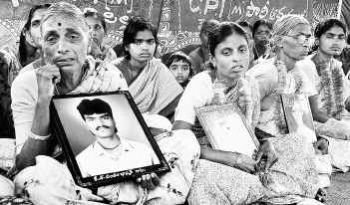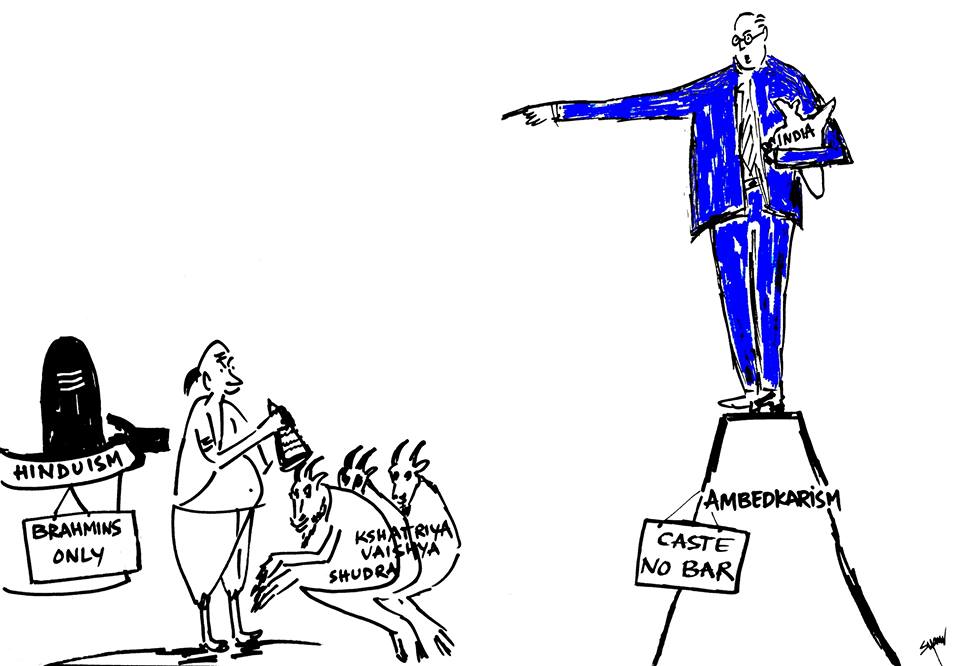Kuffir
In a Times of India column a couple of years ago, Shashi Tharoor tried to stand up for the sari, and was roundly castigated by many readers for trying to impose patriarchal burdens on Indian women, in the name of tradition. In his next column, though apologetic, he still tried to bring back the sari by waxing about its aesthetic qualities. He quoted a woman reader’s message, to drive home his point:
I know that the ultimate weapon in my kitty is the sari… This Sunday I have taken down my Ikat, Chanderi, Puneri, Laheriya, Bandhej, Bomkai, Gadwal, Narayanpet , Maheshwari, Kantha and Kanjeevaram saris and stroked them in the reflecting sunlight.” (I guarantee no man would ever think of doing anything similar with his dhoti collection.) And Sindhu Sheth wrote that she would heed my appeal: “I have decided to wear a sari (instead of my regular churidar-kurta) — once a week, to begin with.” In that “to begin with” lies the hope that my column will not have been entirely in vain….
India is a living museum, thanks to the large presence, despite their small number, of committed aesthetes like Tharoor in the population.
How many of the women who work on turning out Ikat, Chanderi, Puneri, Laheriya, Bandhej, Bomkai, Gadwal, Narayanpet, Maheshwari, Kantha and Kanjeevaram and other fine material can actually afford those saris? The average life expectancy of some weavers in some of those towns those products come from has gone down to around 50 years in recent times, according to some news reports.

The sari is the ultimate weapon in the kitty of a lot of people: it helps wrap up a lot of freedoms. Wrap women in Ikat, Chanderi, Puneri etc., and tie up the lower castes in the production of Ikat, Chanderi, Puneri etc. For the sangh parivar the sari has totemic significance, refined sensibilties are Congressi liberal Tharoor’s excuse. Mr.Tharoor and the RSS top brass might prescribe the sari as essential hindu-fashionwear for women, but would they suggest weaving as a career for their children? Or fishing? Scavenging? Tanning? Toddy tapping?
~
Tradition, culture, nation, women, beauty. It is necessary to look beyond all those pleasantly commonsensical terms at the pernicious ideology that animates them. To look at the other side of the enthralling sari which conceals the not so pretty story of its weaver.
The net effect of the ruling classes clinging to views such as Shashi Tharoor’s is that the number of handlooms in India, which was around 20 lakhs in early nineteenth century, has now grown to around 23.55 lakhs.
Did anyone say ‘industrial revolution’? Well, that happened in the U.K., (and sundry other places in the west) where the number of handlooms, which was around 2 lakhs in early nineteenth century, has now shrunk to just a couple of hundreds or so, mostly owned by hobbyists, in all probability.
When Gandhi took up the charkha, he was actually erasing the wheel of human progress and achievement of many past centuries, especially the last two centuries, before his birth. Marx had said, the hand-mill gives you society with the feudal lord. Look closely, the charkha and the hand operated loom can only give you a society with castes, not just a caste of weavers, because as Dr. Ambedkar put it so plainly, ‘…caste in the singular number is an unreality. Castes exist only in the plural number. There is no such thing as a caste: There are always castes.’ So the hand loom weaver does not come alone, he brings along with him the manual scavenger, the toddy tapper and the tanner, and vice versa.

The hand loom is still the most predominant technology of textile production in India, its face, very slowly and grudgingly yielding its place to power looms over the last one decade or so. Though power looms now produce three times more output than hand looms, the number of hand looms in the country is 25% more than the number of power looms. And the entire power loom sector is as unorganized as the hand loom sector, with most of its workforce again coming from the same artisanal OBC and Dalit communities, across religions, which were earlier associated with weaving and related crafts.
Over the last two centuries the role of those castes in the production of textiles (a sector which employs over 100 million people, more than a fifth of all working population in the country), in the political economy of India, has not changed much. If anything, it has become more rigidly rooted in the same spot. Just as the role of the majority of the castes engaged in agriculture, cattle and poultry rearing, fishing, handicrafts etc., – which in effect means the overwhelming majority of the working population in the country – has also not changed much. Therefore, is it very surprising that social relations in India still stink of caste?
Nehruvad protected the big textile mills from foreign competition, while Indira extended this policy and nationalized the big mills when they were on the verge of closure. Gandhivad ran as an undercurrent through all the textile policies since independence, expressed through reservation of certain products for production in the hand loom sector and other sops.
Now this might seem a fair policy to Gandhian nationalists and Nehruvian liberals like Tharoor (and to the hindutva parivar and the so-called left parivar) because it seemed to protect all sections of the textile industry: the mills and the hand looms. But is that true? In the initial years, the Indian state protected big mills by saving them from imports and later, when the mills become unsustainably uncompetitive, it went on to take upon itself the entire burden of running those mills absorbing all their liabilities and burdens. What was the Indian state actually protecting? The big mill owner, of course; first when he wanted to protect his markets and profits from transnational companies, and second when he needed to run away from losses.
The other facet of the state’s protective policy framework, protection of handlooms, was even more disingenuous. Protection of the so-called hand loom sector should never be interpreted as protection of the hand loom worker (just as the oft-repeated promises of policy makers to make agriculture profitable should never be seen as pledges to make farmers secure). What the handloom sector needed was not reservation, but the elimination of the entire mill sector, to even survive, because it was the mills which were eating away the market which had originally belonged to the hand looms. That kind of policy would have protected the hand loom workers, not just the so-called sector, but would have been regarded, and rightly so, as a totally regressive, anti-industrial, anti-modern policy.

The hand loom worker was lured with the carrot of sops to race on a bullock cart on a road that moved much faster than his vehicle, and against a competitor who drove a racing car. It was a race that was illogical, the hand operated loom can never be as productive as the mechanized, power driven mill. It can never achieve the economies of scale required to compete in a commoditized market, because the hand loom is a lone worker and his family, not an organization like the mill.
If the state wanted to sincerely protect the hand loom workers it should have nationalized all their looms just as it had nationalized the mills. But that did not fit ‘national’ interests, according to Gandhivad and Nehruvad. The upper caste mill owners could be protected, but not the shudra hand loom workers.
What the weaver could not see was the large stick of unavoidable serfdom that came along with the carrot of protection: it gave a ‘modern’ meaning, couched in the language of welfare and socialism, to his caste occupation, but cut him away from meaningful modern opportunities more than ever before, perhaps.
It was inevitable that the Indian weavers’ average incomes should rank lower than average Indian’s national income, average daily earnings much lower than minimum wages most times, and average suicide rate much higher than among average Indians, year after year. The Indian state’s Gandhivad ensured that the weaver earned just enough to sustain himself and his family every day, if he was lucky enough, so that he could reproduce his caste self the next day.
But the biggest betrayal came not from the Gandhivadis or the Nehruvadis but from the so-called left. They can only be called Bhadralokvadis because they could never see the oppression of the Dalitbahujans as caste slavery, a condition much more complex and debilitating than wage slavery.
~~~
Please also read other related articles:
&
Pictures courtesy: the net.









